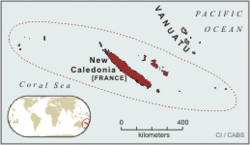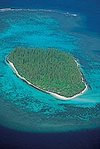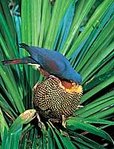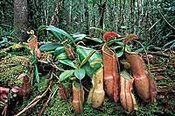Biological diversity in New Caledonia
New Caledonia is one of the smallest hotspots in the world (the size of New Jersey). This group of islands is located in the South Pacific at the southern extremity of the Melanesian region, 1,200 kilometers east of Australia. Until recently a French Overseas Territory, New Caledonia is now in the process of becoming an Overseas Country, with substantial political autonomy that stops short of full independence. The region's 18,972 km2 consist of the main island of Grande Terre and the smaller Loyalty Islands to the east, Belep and Surprise Islands to the north and Isle of Pines to the south. The Chesterfield Islands further to the west, and the uninhabited volcanic islands of Matthew and Hunter to the east, which are politically dependent on New Caledonia are included, though their value for terrestrial biodiversity is limited.
New Caledonia's ecosystems include several natural vegetation types. Evergreen rain forests, which once covered about 70 percent of the area, are now confined to a few scattered pockets in the central mountains. In drier areas on the western coast, there are a few small patches left of sclerophyllous forest. Maquis shrubland dominates the southern third of the island, at both high and low altitudes. High-altitude maquis occupies most of its original extent of around 100 km2, while low-altitude maquis is now the most extensive natural formation in the country. This formation once occupied only about five percent of the country, but has now expanded, largely as a result of fire disturbance, to cover some 4400 km2, or 23 percent of New Caledonia. Other vegetation types include mangroves, along the west coast.
Grassland and niaouli (Melaleuca quinquenervia; an invasive eucalypt) savanna today occupy more than 6000 km2 or 32 percent of the area, and are often mistaken by visitors and residents as the typical landscape of New Caledonia. These are, in fact, highly disturbed anthropogenic formations that are maintained by repeated fire and grazing by cattle and introduced deer.
Contents
Unique and Threatened Biodiversity
New Caledonia is one of the world's smallest hotspots, yet it is very diverse and, like the other remnants of the ancient super-continent Gondwanaland (Madagascar, Australia, and New Zealand), supports high levels of endemism. This rich biodiversity and high endemism are due to its long-isolated evolution, as well as the variety of precipitation levels and very particular ultrabasic soils that cover more than one third of the country.
Plants
Endemism is especially high among vascular plants. There are about 3270 plant species recorded on the islands, 74 percent of which are endemic (roughly 2430 species). There are also 108 endemic genera, and a remarkable five endemic plant families: Amborellaceae, Paracryphiaceae, Strasburgeriaceae, Oncothecaceae, and Phellinaceae. Among countries, only Australia, South Africa, and Madagascar have more endemic plant families; these nations are also vastly larger than New Caledonia. Given this remarkable floristic endemism, New Caledonia is often considered a distinct floristic subkingdom.
Around 2012 plant species are found in the evergreen rainforest, of which 82.2 percent are endemic, making it the richest of New Caledonia's vegetation types. Some 456 plant species have been recorded from the seclerophyllous forest type (57.5 percent endemic). Around 200 plant species occur in high-altitude maquis, of which 91 percent are endemic, and 1,144 plant species occur in the low- to mid-altitude maquis (89 percent endemic).
Exceptional plant groups found in New Caledonia include 44 species of gymnosperms, of which all but one species are endemic, including 13 endemic species of the genus Araucaria, an ancient group of Gondwanaland gymnosperms, of which there are only 19 worldwide, and the world's only parasitic conifer, Parasitaxus ustus. The territory also has 37 endemic species of palms, representing 16 endemic genera out of a total of 17. Furthermore, New Caledonia is home to the endemic, monotypic family Amborellaceae, which comprises a single species, Amborella trichopoda, recently shown to represent the basal-most branch in the evolutionary tree of the flowering plants.
Vertebrates
Birds
Out of more than 100 birds found in New Caledonia, more than 20 are endemic. There are three endemic genera, two of which are monotypic, including the kagu (Rhynochetos jubatus, EN), the only living member of the endemic family, Rhynochetidae. Forest destruction and feral dogs gravely threaten the kagu, and only a few hundred individuals survive. Other distinctive bird species include the endemic New Caledonia imperial-pigeon (Ducula goliath), which is the world's largest arboreal pigeon, the endemic cloven-feathered dove (Drepanoptila holosericea), the New Caledonian owlet-nightjar (Aegotheles savesi, CR) known from only a few specimens, and most recently from an individual seen in 1998 in the Ni Riviere Valley. Two species from Caledonia that have not been recorded reliably for many years, include the New Caledonian lorikeet (Charmosyna diadema, CR), last recorded in 1913, and the New Caledonia rail (Gallirallus lafresnayanus, CR), not reliably reported since the early 20th century. New Caledonia is considered an urgent priority Endemic Bird Area (EBA) by Birdlife International.
Mammals
All of New Caledonia's nine land mammal species are bats; five Microchiropters and four Megachiropters or flying foxes. Six of these bat species are endemic, including a newly described species of long-eared bat (Nyctophilus nebulosus) discovered in 1991 around Nouméa and caught for the second time in the same area in 2000. Bats have been poorly studied and the potential for discovering new species is high. Sadly, Megachiropters are highly threatened due to hunting. These species play a major role in dispersing the seeds of many rain forest tree species; when not hunted, they can develop large populations.
Reptiles
There is an extremely high level of reptile endemism in this hotspot. More than 60 of about 70 terrestrial reptiles are endemic, as are 11 of 23 genera. Nearly all of these species are lizards in two families of geckos and one family of skinks. The best known among these are the giant geckos of the endemic genus Rhacodactylus. Rhacodactylus leachianus, the largest gecko in the world, can grow up to 28 centimeters long, and weigh up to 700 grams. Phoboscincus bocourti, a 50-cm-long lizard, was previously known from a single specimen captured around 1870 and was long presumed extinct. In 2003, on a tiny islet, Phoboscincus bocourti was rediscovered.
The hotspot's two snake species, the Pacific boa (Candoia bibroni) and a small burrowing blind snake (Ramphotyphlops willeyi) from the family Typhlopidae, are restricted to the Loyalty Islands.
Amphibians
There are no native amphibians on New Caledonia.
Freshwater Fishes
Aquatic diversity on the islands is high given the size of the hotspot, with about 85 species of freshwater fish, although less than 10 are endemic. The most notable species is perhaps the endemic galaxiid Galaxias neocaledonicus, the northernmost representative of a group that is mostly restricted to the southern tips of New Zealand, Australia, South America, and Africa. A single genus, Protogobius, is endemic.
Invertebrates
Among invertebrates, the hotspot supports a rich endemic diversity of land snails, although only 200 species have been described out of an estimated 400 to 600 species. The largest of these snails, Placostylus fibratus, can grow to more than 15 centimeters long and weigh up to 100 grams.
The hotspot has an estimated 37 species of macro-crustaceans, of which 40 percent are endemic. Grande Terre island is one of the most biodiverse islands for this taxonomic group, with species found only in ultrabasic substrata and others only in some short, oxygenated rivers of the north. Some gravely restricted species are highly threatened by nickel mining.
About 4,000 insect species have been catalogued to date, showing high endemism at the species and genus levels. The total insect fauna in the hotspot is projected to be between 8,000 and 20,000 species, including more than 70 native species of butterfly, more than 300 species of moth, and 16 tiger beetles. Nearly 200 spiders have been recognized thus far, including the only family of spiders endemic to a single island, the Bradystichidae.
Human Impacts
New Caledonia has the largest known deposits of nickel in the world. Nickel mining generates about 90 percent of the region's foreign exchange at present and produces fully half of the world's nickel. However, this asset is also a threat to the island's ecosystems. The impacts of the nickel mining industry have been devastating. Open-cast mining has led to large expanses of deforestation and habitat destruction, resulting in bare slopes and waste heaps. The erosion of mining devastated areas has caused the siltation and destruction of streams and offshore coral reef areas and the pollution of water supplies. Today, open-cast mining is better managed, and more localized than in the past. However, two new large-scale nickel mining and processing sites are presently threatening the adjacent coral reefs and very localized plant and animal species. Even though environmental impact studies have been undertaken and mitigation measures implemented, some very highly adapted species will probably disappear.
Other pressures on New Caledonia's biodiversity now include bush fires, logging, hunting and selective illegal collection of animals. The most valuable timber species are already gone, but even limited logging threatens the habitats of species with highly restricted ranges. Like other islands in the Pacific, hunting and habitat modification since the arrival of the first humans has led to a number of extinctions, including 11 species of non-passerine birds, and continues to pose a threat to the New Caledonian imperial-pigeon and to flying foxes. International demand for rare species of birds and marine animals, such as the Uva parakeet (Eunymphicus uvaeensis, EN), the horned parakeet (Eunymphicus cornutus, EN), and an endemic "living fossil" cephalopod (Nautilus macromphalus), threatens the already sparse populations of these species.
The intentional and accidental introduction of alien species for food or recreational purposes has been devastating. There are nearly 800 alien plant species, more than 400 alien invertebrates, and some 35 alien vertebrates established on the islands (including an introduced amphibian), out-competing and replacing much of the original vegetation and faunal species. Among the most problematic of these introductions have probably been the ship rat (Rattus rattus), the Indonesian deer (Cervus timorensis) and the fire ant (Wasmannia auropunctata). Pigs, cats, deer and rats occur from sea level to the highest elevations, and are present throughout the main island. The combined effect of these four species is dramatic and is rapidly destroying species and ecosystems. Controlling these species is the top conservation priority in the hotspot, including inside protected areas. This very demanding task is the only way to conserve fragile and localized species. The palm tree Lavoixia macrocarpa (CR), only known from 30 trees, is highly threatened due to seed predation by rats. Ouvea island is currently free of ship rats; if the species is introduced, it will likely wipe out the entire population of the Uva parakeet (Eunymphicus uvaeensis, EN). Feral dogs are now breeding in the wild and could be the reason why the kagu (Rhynochetos jubatus, EN) have disappeared from the north of Province Nord within the last 30 years.
Today, of the 5,050 km2 of relatively pristine habitat left in New Caledonia, 4,000 km2 are rain forests and 1,000 km2 are low- to mid-altitude maquis. Sclerophyllous forest once covered around 23 percent of New Caledonia, but now only exists in a patch of around 45 km2. This area itself is generally very degraded and fragmented into smaller patches of 20-30 hectares or less (though there are a few blocks that exceed 100 hectares), which are surrounded by agricultural land. A recent study suggests that New Caledonia's sclerophyll forest is the most threatened tropical dry forest in the world.
Conservation Action and Protected Areas
New Caledonia has a protected area network covering 4,192 km2, or 22 percent of its land. However, the 24 reserves that are classified in IUCN categories I to IV cover a mere 497 km2 (2.6 percent of the land). Furthermore, 83 percent of the territory's threatened plant species do not occur in any protected area. The extremely rare sclerophyllous forest and the low to mid-altitude maquis vegetation types are almost totally unprotected.
Many new reserves are needed to protect the threatened species and ecosystems of New Caledonia adequately, and there are a number of problems within existing reserves. The lack of effective management for protected areas and the dismal enforcement of protective legislation are two such challenges. Only half of the existing parks have any restrictions on mining within their boundaries, and the remaining ones are open to mining activities. There is little conservation awareness among the population of New Caledonia, particularly with respect to the terrestrial environment. Funding conservation work in the hotspot is difficult, because agencies like the World Bank and the European Union will not designate money for work in New Caledonia, which is technically part of France. France, recently, has made the conservation needs of the island a priority.
Few international non-governmental organizations (NGOs) are active in New Caledonia, but a small number of local NGOs, including Association pour la Sauvegarde de la Nature Neo-Caledonienne, have spent considerable effort promoting conservation in the territory. More recently, international NGOs have also become involved in New Caledonia. WWF has worked since 1997 with local partners to implement a sclerophyllous forest conservation program. BirdLife International has begun a two-year Important Bird Area assessment, and Conservation International has supported the Maruia Society's effort to implement local conservation in the Mt. Panie massif. A collaboration between the Maruia Society, CI, and the Government of Province Nord, the Mt. Panie project aims to conserve biodiversity of the area by targeting threats to biodiversity (mainly fires and invasive species) and involving local people in management activities including locally controlled toursm development.
Important steps towards achieving conservation goals in the hotspot include the identification and conservation of Key Biodiversity Areas within the hotspot; a rapid assessment of existing protected areas and other natural areas; legislation and policies to promote conservation and sustainable resource management; creation of models for co-management between local communities and government; increased education and public awareness; strengthening of existing legislation; creation of new policies and protected areas; and strict control of invasive species.
Further Reading
| Disclaimer: This article ontains information that was originally published by, the Conservation International. Topic editors and authors for the Encyclopedia of Earth have edited its content and added new information. The use of information from the Conservation International should not be construed as support for or endorsement by that organization for any new information added by EoE personnel, or for any editing of the original content. |






1 Comment
Tim Upham wrote: 08-31-2012 18:35:07
The New Caledonia Great Barrier Reef is the second largest great barrier reef in the world. The world's highest biodiversity of sea snails is found in the waters off New Caledonia. There are two families of sponges, that are considered living fossils, and the waters off New Caledonia is one of the last refuges of the endangered dugong. The waters off New Caledonia also has an endemic species of nautilus. But on the land there are 3,380 species of endemic plants, including the world's only parasitic conifer. There are also 22 species of endemic birds on New Caledonia, including the kagu, which is also New Caledonia's only endemic family of birds. New Caledonia is a living laboratory of biodiversity, that rivals the Galapagos Islands and the Hawaiian Islands.